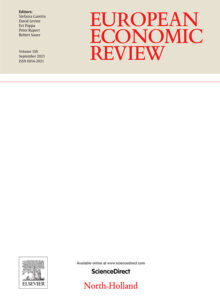“Emerging Challenges for Monetary Policy”

European Economic Review Special Issue
After decades of low inflation and interest rates, the global economy has entered a period characterized by high and volatile inflation. This change has coincided with, and in some cases resulted because of, various shocks and new structural forces affecting the global economy—including supply disruptions, higher energy and food prices, political tensions and geo-economic fragmentation, climate change and increased market power.
What role Monetary Policy should play to address these forces? And how is its effectiveness affected by them? For example, should central banks adopt climate change considerations in their monetary policy frameworks, given their current legal mandates (see e.g., Lagarde, 2021, and Powell, 2023)? How the level of firms’ markup affects the ability of monetary policy to stabilize output and inflation?
Apart from the effects of shocks on the rise in inflation, what role did monetary policy play in contributing to that rise? With the monetary aggregates increasing at record rates in many currency areas in 2020, and with policy rates held to near zero, was monetary policy too expansionary during the early stages of the recent episode of high inflation? Why did monetary policymakers miss the intensity and persistence of the inflation episode, classifying it—both in the U.S. and in Europe—as “transitory”?
What are the implications of the higher inflation for the inflation targeting regimes followed by many central banks? What role did inflation spillovers among major currency regions play in the recent upsurge in inflation?
Against this background, the EER SI would look for contributions examining recent and new challenges affecting the design and the effectiveness of monetary policy. Topics of interest include, but are not restricted to, the interplay between monetary policy and:
- Measurement and anchoring of inflation expectations.
- Market Power and Monopsony
- Digitalisation, innovation and productivity
- Reallocation and labor market dynamics
- Geo-economic fragmentation and (de)globalization
- Climate change and decarbonisation
- The role of monetary policy during supply side shocks
- Monetary policy and inflation targeting
- Inflation spillovers among currency regions
“Policy Making in Periods of Structural Changes and Structural Breaks.”

Journal of Forecasting Special Issue
There is a substantial literature dealing with structural breaks and model uncertainty. The experience of the past few years, however, has brought to the fore the importance to policy makers of detecting and reacting to structural breaks in a timely manner.
In this connection, this special issue would focus on the problem of policy formulation when a structural break may be taking place. It is clear that following the shocks which hit the global economy since early 2020 (COVID followed by rises in energy prices pre-Ukraine war and then Russia’s invasion of Ukraine), fiscal and monetary policies in the major currency areas were slow to react to the inflationary consequences of the successive shock. Initial policy statements were supportive of the idea that the rise in inflation would be transitory – that it would quickly revert to the low levels which had been experienced since 2000. Only reluctantly did policy makers realise that the combined shocks imposed a structural break that needed a strong and timely policy response. In such conditions, what is the role of the policy advisor? Most of the literature on structural breaks has focused on developing tests for structural breaks that identify the break only in the middle of a sample period. (These tests certainly are not well suited for identifying the occurrence of a break that takes place in the last 10% or 20% of the sample period). Yet, as the experience of the past few years has shown, policy makers need to know about the occurrence of a break during its initial stages.
The special issue would concentrate on techniques that could act as a form of indicator or possible warning of a structural break. These could include endogenous switching models, conditional or stochastic volatility models in which the time varying volatility might be an alert indicator, recursive stability tests, model uncertainty procedures focusing on the latest data, real time data analysis, rolling windows using a short window length, time varying parameters and Bayesian approaches to structural breaks. It would also be interesting to see studies using Monte Carlo analysis to asses some of these techniques.
